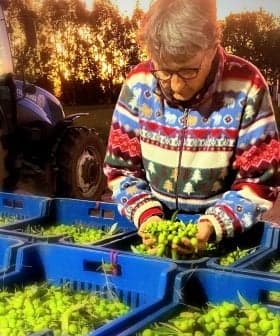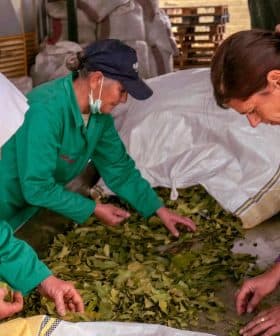How Expert Advice is Helping Catalonia’s Olive Oil Sector
Agustí Romero from IRTA’s olive oil research team discusses issues faced by the olive oil sector, such as the impact of yellow color on consumer preferences and the misconception that unfiltered oil is superior. IRTA advises producers on choosing the right market based on factors like antioxidant content and flavor profiles, and works with chefs to translate sensory characteristics of olive oil for culinary use. The global olive oil sector faces challenges with deodorization, as refineries can easily remove odor defects from lampante oils, making it difficult to detect soft-deodorized oils in virgin olive oil.

From olive oil that’s too yellow, to the perils of excessive pungency and the ‘unfiltered is best’ fallacy – these are among the issues the Catalan agriculture, food and aquaculture research institute (IRTA) has recently dealt with as part of its work with the olive oil sector. Agustí Romero, from IRTA’s olive oil research team, shares more:
Q. What are some recent examples of your work with producers?
A. I recently spoke to one whose oil is quite yellow. That makes no difference to quality or healthfulness but his customers prefer green extra virgin olive oil.
In this case the likely reason is that the small (less than 300kg/hr of olives) centrifuge he uses – one used by a lot of small producers – tends to remove plant-derived chlorophyll from the oil. Our advice was to invest in a new machine that doesn’t do this, if this is a critical point for sales.
In another case, a producer of oils from Argudell olives was shocked by the very different sensory results for two of his oils – one filtered and the other not. The filtered one was fresh, green, intense, complex and rich in polyphenols, but the unfiltered one was cloudy and lacked complexity and flavor and that’s because it contained some water in suspension.
The grower was surprised to hear this because many Catalan producers think people prefer unfiltered oil, that it’s easier to sell, and that because seed oils are filtered, virgin olive oil must be set apart by not filtering it. But many experiments show unfiltered oil loses a lot of its intensity, even in the first five hours. After a short time in the bottle, filtered oil is organoleptically better.
Q. What are some examples of how IRTA helps producers find the right market?
A. Many growers produce only small volumes so it’s easier if they focus on one market. We advise on how to choose it and sell there. For instance, the balance of antioxidants, polyphenols, pigments and flavors affects shelf life and whether you should sell to near or far markets.
The U.S. is a very long rotation market so you need virgin oils with a shelf life of at least two years, ruling out varieties that are very low in polyphenols. It also implies early harvesting. Buyers there are more demanding and specific about what they want, for example asking for green, sharp or complex oils. China seems to be a faster market but requires more marketing inspiring confidence in a product’s quality, so labeling and certification are crucial.
Q. How does polyphenol content affect marketing?
A. Current chemical tests measure total polyphenol content but sensory analysis tells us about bitterness, pungency and astringency and allows us to split this up a little.
For instance oleocanthal is the polyphenol most associated with pungency in the throat and it’s very stable, it lasts well in virgin olive oil so when you have a lot of pungency you have a problem because consumers accept a certain level of pungency but not too much, and if you have this problem it persists for the oil’s entire shelf life.
The polyphenols that cause astringency (mainly tyrosol) are very good antioxidants and the first to decay, then those that produce bitterness (mainly the derivatives of oleuropein), and then those responsible for complexity of flavor (volatile compounds from the lipoxygenase (LOX) pathway).
Producers feel proud if their oil has a high overall level of polyphenols, and for the US market we recommend they aim for the maximum level at point of origin – because the oil then has to get there – but what is needed is a medium intensity of pungency and bitterness because people generally don’t like too much. It depends on the variety but that usually means levels of 300 – 500 ppm of polyphenols as caffeic acid.
Q. How are growers capitalizing on Catalonia’s ancient olive trees?
A. In the south of Catalonia there are some 4,400 trees aged 700‑1000 years old. This allows the production of a special line of oil certified as from these ancient trees and we’ve been working along two lines to help get a good price for it.
One is looking at the differences between virgin olive oil from these trees and from younger trees. It’s very hard to differentiate between trees of the same variety if the olives are of equal quality and the cultivation methods the same. But the old trees’ larger roots go deeper and that may be why the isotopic composition of the oil differs. Isotopes don’t smell so have no impact on the sensory properties of the oil but we can say that these trees work in a different way to young trees.
We also asked chefs to create recipes for meals related to this area and using this olive oil and now have a dedicated cookbook.
Q. Why did you work with chefs on olive oil nomenclature?
A. We’re working with chefs through the Alícia Foundation (a food science research center near Barcelona) to translate the language tasters use to discuss an olive oil’s characteristics, such as fruitiness and bitterness, into what chefs use, for instance they might use the terms aromatic and sharp to describe a complex olive oil with green fruitiness.
This helps when they do tests on frying with different oils such as canola, sunflower oil and virgin olive oil to see if one improves the final meal. As virgin olive oil isn’t just one product – there are hundreds of different aromatic profiles – it helps select the best virgin olive oil for a particular cooking process.
Q. What is the main challenge for the global olive oil sector?
A. Deodorization is the biggest problem now because there are lots of lampante oils and, unlike in the past, they’re not so bad, they’re often near the level of virgin oils. It’s quite easy to find a lampante oil that’s chemically perfect but has a sensory defect, such as tasting vinegary or of frostbitten olives. Refineries buy these oils and simply remove the odor defects. It’s quite easy and the oil doesn’t change at molecular level so it’s hard to identify when a virgin oil contains a certain amount of soft-deodorized oil.









